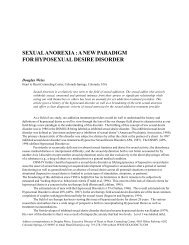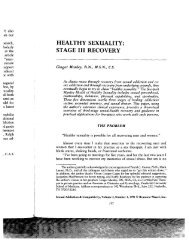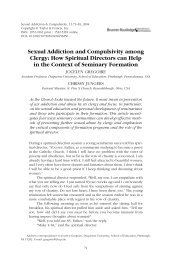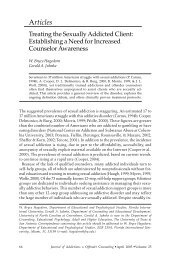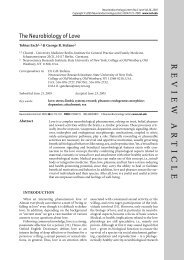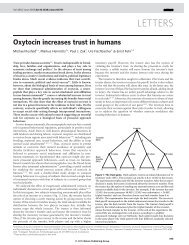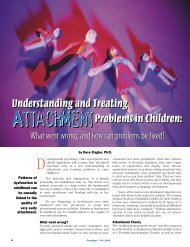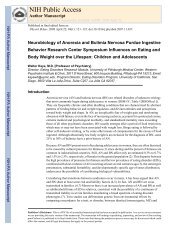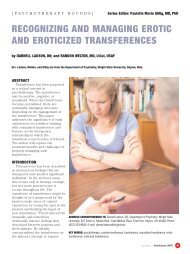Coverage and Liability Issues in Sexual Misconduct Claims
Coverage and Liability Issues in Sexual Misconduct Claims
Coverage and Liability Issues in Sexual Misconduct Claims
- No tags were found...
You also want an ePaper? Increase the reach of your titles
YUMPU automatically turns print PDFs into web optimized ePapers that Google loves.
Part III.Overview of Civil <strong>Liability</strong> <strong>and</strong>Insurance <strong>Coverage</strong> <strong>Issues</strong> <strong>in</strong> <strong>Sexual</strong> <strong>Misconduct</strong> <strong>Claims</strong>In civil actions for damages, the most common causes of action asserted aga<strong>in</strong>st perpetrators are assault,battery <strong>and</strong> breach of fiduciary duty. The most common causes of action asserted aga<strong>in</strong>st other potentiallyliable parties, such as the perpetrator’s supervisors, relatives <strong>and</strong> co-workers <strong>in</strong>clude: negligent hire,retention <strong>and</strong> supervision; vicarious liability; <strong>and</strong>, failure to warn or report the abuse. The typical remediesare compensatory <strong>and</strong> punitive damages. <strong>Sexual</strong> misconduct claims aga<strong>in</strong>st government agencies <strong>and</strong>school boards can <strong>in</strong>clude civil rights allegations that allow a prevail<strong>in</strong>g pla<strong>in</strong>tiff to recover attorneys’fees.Defenses available to all defendants <strong>in</strong>clude denial of sexual misconduct, contributory negligenceby the victim <strong>and</strong> the statute of limitations. The most common defenses available to non-perpetratordefendants are to deny notice of the abuse or of the perpetrator’s deviate propensities <strong>and</strong> to argue that theperpetrator’s activities were outside the course <strong>and</strong> scope of an employment or agency relationship. Notfor-profitentities may have defenses based on charitable immunity. Government agencies may also haveimmunity defenses. Ecclesiastical defendants may have defenses based on the First Amendment. Certa<strong>in</strong>professionals may have physician-patient <strong>and</strong> clergy-penitent privileges.This booklet does not purport to address all liability <strong>and</strong> coverage issues that may arise <strong>in</strong> connection withsexual misconduct claims. Below is a brief description of 5 specific subject areas, followed by a subject area<strong>in</strong>ventory table, <strong>and</strong> then a state-by-state detail of current law.Tim<strong>in</strong>g <strong>and</strong> Number of Occurrences/<strong>Claims</strong>In “occurrence” policies, courts have been <strong>in</strong>consistent regard<strong>in</strong>g policy triggers <strong>and</strong> number of occurrenceissues. Decisions range from one occurrence for each policy period dur<strong>in</strong>g which sexual misconduct tookplace to the other extreme that all victims abused by a s<strong>in</strong>gle offender over any number of policy periodsconstitute one occurrence. Due to lessons learned <strong>in</strong> coverage actions <strong>in</strong>volv<strong>in</strong>g “occurrence” policies,most modern “claims made” policy forms are specific. The number of limits available <strong>and</strong> the proper dateof loss are clearly del<strong>in</strong>eated despite the number of victims, perpetrators or policy periods <strong>in</strong>volved.<strong>Coverage</strong> for Intentional ActsMost courts have held that the <strong>in</strong>jury is deemed expected or <strong>in</strong>tended by an <strong>in</strong>sured when the characterof the act is so reprehensible that an <strong>in</strong>tention to <strong>in</strong>flict <strong>in</strong>jury must be <strong>in</strong>ferred as a matter of law <strong>in</strong> casesof sexual misconduct to m<strong>in</strong>ors. However, there are decisions that an <strong>in</strong>sured is covered <strong>in</strong> a suit alleg<strong>in</strong>gsexual molestation unless the <strong>in</strong>sured’s <strong>in</strong>tent to cause harm to the claimant is proved.Also, as a general rule, most <strong>in</strong>surers do not provide coverage to the abuser because his or her conductwould be deemed <strong>in</strong>tentional <strong>and</strong> may be outside the course <strong>and</strong> scope of coverage available to anyparticular “<strong>in</strong>sured”. However, some current coverage forms provide a defense to an alleged abuser forthose <strong>in</strong>sureds who need to attract, reta<strong>in</strong> <strong>and</strong> otherwise protect volunteers <strong>and</strong> workers that may be atrisk of be<strong>in</strong>g falsely accused of sexual misconduct.In general, courts have found that <strong>in</strong>surers have a duty to defend claims assert<strong>in</strong>g negligent retention <strong>and</strong>supervision or premises liability. Nonetheless, courts have found no duty to <strong>in</strong>demnify when an <strong>in</strong>suredknew or should have known that the employee’s sexual misconduct was substantially probable. Other– iv –



